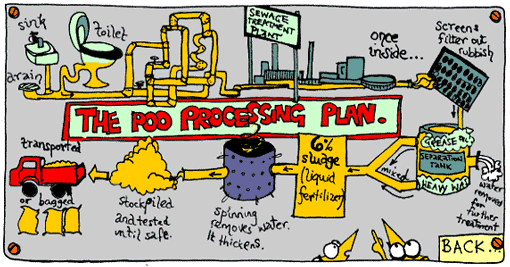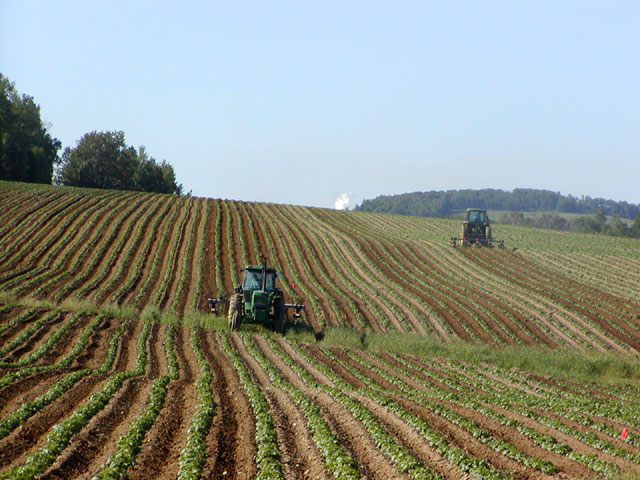Biosolids, more commonly, but inaccurately known as sewage sludge, are the remnants of the process of cleaning and filtering waste water. During the late 1980s, applying this material to agricultural land became popularized after new laws were passed, prohibiting dumping biosolids in water. This use of biosolids is quite controversial, but it seems to be the best choice in consideration of the economy, the environment, and the few choices we have in handling human waste.
Biosolids contain many substances (i.e. phosphorus, nitrogen) and nutrients (i.e. zinc, iron, copper) that are essential to plants and soil that they grow on. Biosolids are packed with organic materials that are a good alternative to expensive commercial fertilizer. Not only that, but it is free for farmers.
If not used as fertilizer, where else would biosolids go? They would be rid of and would harm the environment along the way. Incineration just creates more waste, deadlier and more harmful than before to humans and the earth. If the material is dumped in landfills they will just build up, but we are already running out of dump sites.
Those who oppose the use of biosolids may claim that it is dangerous and unsanitary. It is waste material, after all. But that shouldn’t be much of a concern; the material has, in fact, endured many of the same treatment processes as the tap water that you drink and crops are washed before prior to being shipped off. The biosolids and even the land that it will be put on must meet certain requirements. And just like commercial fertilizers, there are limitations for the safe amount of use of biosolids.
The governments continue to use biosolids and assure us of its safety. Some scientists say that the heavy metal content in biosolids may permanently destroy the farmers’ soil. However, they have no certainty as to how much of any metal is too much. The supposed adverse effects of biosolids have not been thoroughly and properly researched and the Environment Protection Agency says that any of the substances found in biosolids do not put humans’ health at risk. As long as the metal levels are closely monitored, this shouldn’t be much of a problem.
Since there are, admittedly, hazards of using biosolids, humans must be careful in what we do. Make sure to rid of hazardous wastes properly. Don’t assume that when you are pouring household chemicals down the drain, it will vanish forever. It will come back and affect you, and negatively. Rather, use natural and organic products. And if you must use materials such as chemicals, cooking oil, and paint dispose of them via Household Hazardous Waste Depots.
As long as we responsibly dispose of our wastes and stop thinking of them as ‘gross’ and futile material, biosolids are a great sustainable alternative for agriculture. We are ultimately the ones responsible for the quality of the biosolids, which, in turn, affect the crops we consume.
Works Cited
- Renner, Rebecca. "Sewage Sludge, Pros & Cons." Mindfully.org. Mindfully, 1 Oct. 2000. Web. 10 May 2011. <http://www.mindfully.org/Pesticide/Sewage-Sludge-Pros-Cons.htm>.
- "Sewage Biosolids: A Valuable Nutrient Source."omafra.gov.on.ca. Ontario Ministry of Agriculture, Food and Rural Affairs, 7 Apr. 2011. Web. 10 May 2011. <http://www.omafra.gov.on.ca/english/nm/nasm/sewbiobroch.htm>.
- Ferguson, Kevin. "'Biosolids' and Human Health." NYTimes.com. New York Times, 16 Apr. 2009. Web. 10 May 2011. <http://green.blogs.nytimes.com/2009/04/16/biosolids-and-human-health/>.
- "The Problem." GreenPeace.org. Greenpeace International, 30 Nov. 2004. Web. 10 May 2011. <http://www.greenpeace.org/international/en/campaigns/toxics/incineration/the-problem/>.
- "Biosolids - Frequently Asked Questions."www.ecy.wa.gov. Department of Ecology - State of Washington. Web. 10 May 2011. <http://www.ecy.wa.gov/programs/swfa/biosolids/faq.html>.
Images from:
- http://green.blogs.nytimes.com/2009/04/16/biosolids-and-human-health/
- http://www.dayton-knight.com/projects/wwtp/salmon%20arm%20WPCC.htm
- http://www.dpi.nsw.gov.au/forests/education/adventure/biosolids/making-biosolids/processing
Blogs I commented on:







